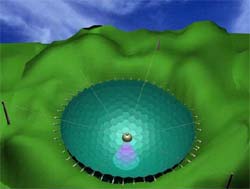
CAS has kicked off the construction of a five-hundred-meter aperture spherical telescope (FAST) at a Karst valley in Pingtang County, Guizhou Province, in southwest China. When completed, it will be the most powerful single dish radio telescope with the largest aperture in the world.

An artist's rendition of FAST.
While observing the world around us via an optical telescope with information carried by visible light, which constitutes only a small portion of the electromagnetic spectrum, astronomers use the remainder of the spectrum to reveal extensive data about celestial objects. For instance, they use telescopes operating in the radio spectrum to explore the Universe.
At present, the world's largest single-aperture radio telescope is the Arecibo telescope located in Arecibo, Puerto Rico, whose 305-meter dish is fixed in the ground and steerable within about 20° of the zenith.
To futher promote studies in this field, CAS has started the construction of a five-hundred-meter aperture spherical telescope (FAST) at a Karst valley in Pingtang County, Guizhou Province, in southwest China. With a total collecting area about 30 football fields, FAST will be the most powerful single dish radio telescope with the largest aperture in the world.
When completed, its overall capacity will be 10 times larger than Arecibo telescope, and its observation sensitivity 10 times more powerful than the 100-m aperture steerable radio telescope in Germany, Prof. NAN Rendong, chief scientist of the project and a researcher from the National Astronomical Observatories at CAS (NAOC), was quoted as saying by
China Daily.
As a major project supported by the National S&T Infrastructure Program in the 11th Five-year Plan Period (2006-2010), FAST embraces three major innovative concepts developed independently by CAS researchers, noted CAS Vice President ZHAN Wenlong at the foundation-laying ceremony held on 26 December at its construction site.
These outstanding ideas include: the unique Karst depression as the site; the active main reflector which corrects spherical aberration on the ground to achieve full polarization and wide band without involving complex feed system; and the light focus cabin driven by cables and servomechanism plus a parallel robot as its secondary adjustable system to carry the most precise parts of the receivers.
Preparation and research for the project took some 13 years. This October, a proposal for FAST, a brainchild of over 20 research institutions and universities under the coordination of NAOC, received the green light from the central government. The 70-million-yuan telescope is expected to be operational in five and half years.
This telescope will be a platform for basic research in various fields, ranging from large scale structure of the universe to in-depth structures and patterns of matter, according to Prof. Nan.






